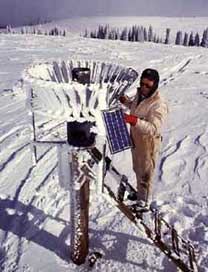|
Effects of Climate Change on Heavy Lake-Effect Snowstorms near Lake Erie and other Great Lakes Lake-effect snow is a common cold season phenomenon in the Great Lakes region, occurring most frequently in late autumn and early winter. This type of snow results from the rapid warming and moistening of Arctic air masses that pass over lakes that are still relatively warm. The Arctic air becomes unstable and the resulting convection forms clouds and precipitation. The precipitation falls over and downwind of the lakes. For very cold air masses, temperatures remain below freezing even after passage over the warmer lakes, causing the precipitation to fall as snow. Lake-effect snow causes considerable enhancement of snowfall in narrow snowbelts along the downwind lakeshores. For example, Detroit, Michigan, on the western (upwind) shore of Lake Erie receives an average of 42 inches per year, while Buffalo, New York, on the eastern (downwind) shore of Lake Erie, receives an average of 92 inches per year. Climate scenarios from two General Circulation Models: CGCM1 and HadCM2 suggest that the climate will be 2-4 °C (3.6-7.2 °F) warmer and about 25% wetter by the end of the 21st century. There will also be fewer cold air outbreaks and less lake-effect snow in winter – especially around the southern lakes (Erie and Ontario). Such changes in snowstorm frequency would decrease the cost of snow removal and decrease the frequency of transportation disruptions. However, there would be adverse consequences to the winter recreational industry in southern portions of the Great Lakes. Such was the case over most of the Great Lakes region during the 1997-1998 El Niño year. The widespread nature of this event resulted in impacts over a large area. For example, business at Midwestern ski resorts was down 50% and losses were estimated at $120 million. (Regional Summary: Climate Change and Lake Effect Snow (PDF version) available here!) |
|
